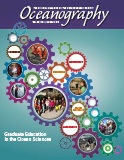First Paragraph
Ocean science graduate students face a challenge. They must prepare for two careers: research scientist and communication specialist. Successful researchers have to be creative, innovative, and competitive within their disciplines in order to promote their work and build collaborations among their peers. But, the higher stakes surrounding current environmental concerns, shifting public perceptions of science, and growing emphasis on broader impacts mean that scientists also have to be effective communicators, able to explain the value of their research to a wide audience. How do we effectively give graduate students an edge in preparing for this dual role?

